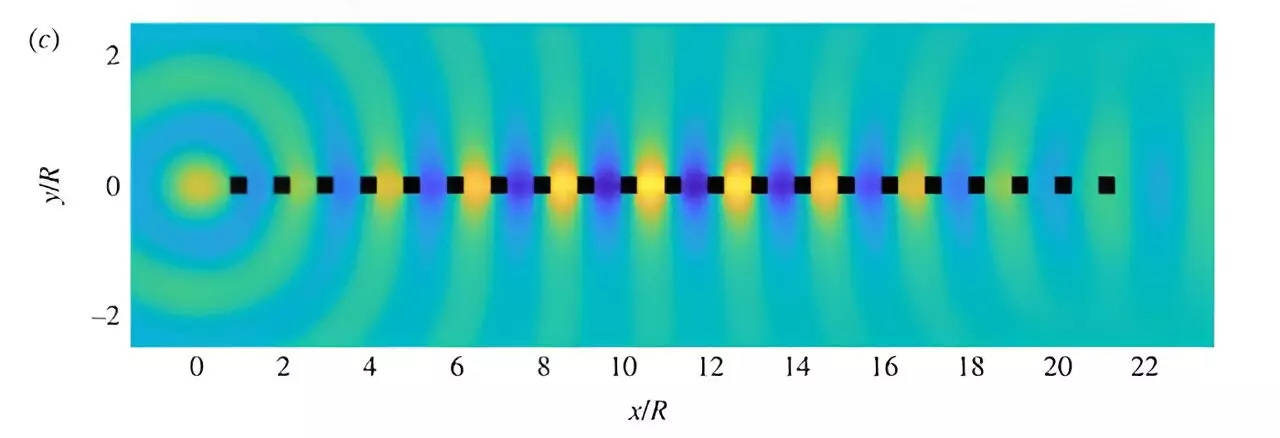Recent advancements in computational science have led to the creation of groundbreaking tools that revolutionize the way we understand and manipulate materials. One such tool, TMATSOLVER, has emerged from the innovative minds at Macquarie University. This software package stands at the forefront of metamaterial research, promising to enhance our capability to design materials that interact with waves—be it sound, light, or water. Published in the esteemed journal Proceedings of the Royal Society A on June 19, 2024, the research surrounding TMATSOLVER highlights its potential to transform various fields reliant upon wave manipulation.
At the core of TMATSOLVER lies the transition matrix (T-matrix), a sophisticated numerical framework that effectively describes the behavior of how particles scatter incoming waves. Although the concept of the T-matrix has been around since the 1960s, the team behind TMATSOLVER has significantly progressed in computing the T-matrix for larger particles exhibiting complex geometries. This represents a leap forward in theoretical and practical applications, as it allows for the modeling of configurations that were previously challenging or impossible to simulate.
Dr. Stuart Hawkins, lead author of the research, emphasizes this advancement, noting how TMATSOLVER can handle numerous scatterers, providing the flexibility required for real-world behavior. This capability means that researchers can explore a variety of particle arrangements and properties without being bogged down by computational limitations.
The development of TMATSOLVER has not been a solitary endeavor. It is the result of collaborative work among mathematicians from reputable institutions—not only from Macquarie University but also from prominent universities such as the University of Adelaide, University of Manchester, and a host of others in Germany. This multifaceted collaboration enhances the tool’s reliability and functionality, reflecting the combined expertise and diverse insights of various researchers in the field.
Dr. Luke Bennetts from the University of Adelaide noted that utilizing TMATSOLVER has streamlined the process of conducting numerical computations necessary for testing metamaterial theories. This underscores the importance of collaboration in advancing scientific knowledge, as professionals across different specialties converge to develop innovative solutions that benefit the entire community.
The capabilities demonstrated through TMATSOLVER are exemplified through concrete problems presented in metamaterial design. These include a variety of complex particle arrangements, ranging from anisotropic particles to high-contrast square particles and tunable periodic structures aimed at manipulating wave propagation. Metamaterials, by their definition, display unique characteristics not found in nature, making them critical players in the domains of optics, acoustics, and electromagnetic wave control.
Real-world applications of these materials are vast. From super-lenses that enable unprecedented microscopic views to invisibility cloaks capable of bending light in extraordinary ways, metamaterials have the potential to redefine various technological landscapes. Moreover, they hold promise for enhancing energy efficiency through perfect wave absorption techniques, contributing to noise reduction strategies, and setting the stage for future innovations.
The significance of TMATSOLVER extends beyond its computational proficiency; it symbolizes a major advance in our pursuit of designing materials that can manipulate wave interaction with astonishing precision. As stated by Professor Lucy Marshall, Executive Dean of the Faculty of Science and Engineering at Macquarie University, this research exemplifies how innovative computational methods can propel materials science into new realms.
The potential for rapid prototyping and validation of metamaterial designs provided by TMATSOLVER may very well accelerate breakthroughs in this burgeoning field, affecting not just academic research but also commercial applications within the global market. As researchers continue to explore and apply this technology, we can anticipate transformative changes that will echo across multiple industries, paving the way for the next generation of materials that interact with the environment in previously unimagined ways. The future of material science is promising, bolstered by tools like TMATSOLVER, which offers unprecedented design capabilities and reflects our growing understanding of the complex interactions between particles and waves.


Leave a Reply